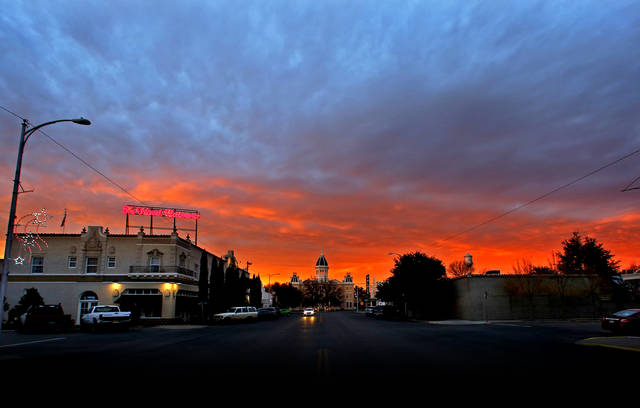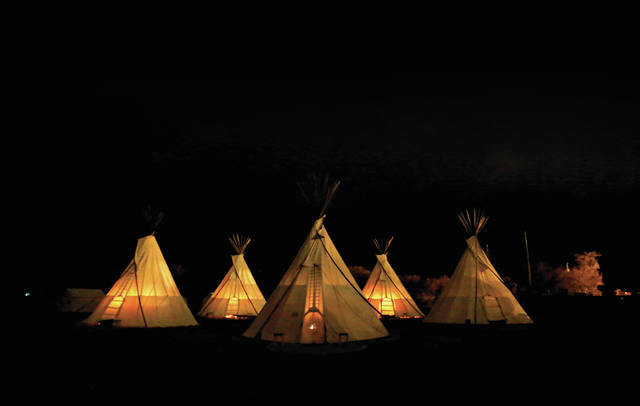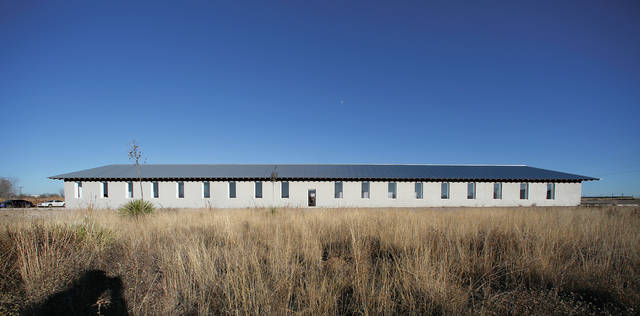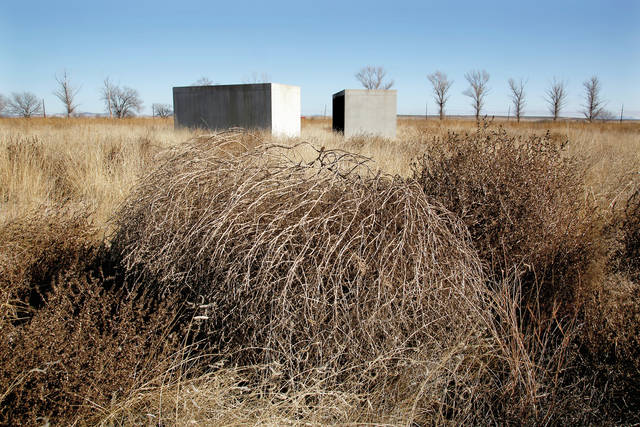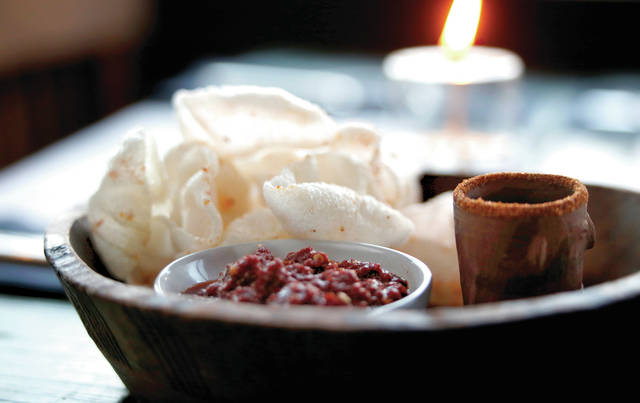Marfa, Texas … unvarnished
You may have read, or more likely heard, all kinds of things about Marfa, Texas. That it’s super cool. That it’s a foodie destination. That it’s right next to Big Bend. That it’s completely overrated.
ADVERTISING
If you’ve been to the fabled West Texas town, you undoubtedly have your own opinion about it, perhaps a strong one.
If you haven’t been, maybe you’re thinking of heading there one day soon. Plenty has been written on the subject, much of it pretty puffed up. I’m here to give you Marfa, unvarnished.
First, a few things to get out of the way: The fake Prada store is not in Marfa. It’s 26 miles out of town, to the northwest, but ART (with a capital A-R-T) and artifice are everywhere in town. Even the tumbleweeds look curated. Most people you see on the street (and in the galleries and boutiques and dining rooms) look wealthy. Bearded hipster dads and tattooed moms push babies in expensive strollers. Cool-looking older couples (she with beautiful long gray hair, he with fabulous turquoise jewelry) sip espresso in front of the new boutique hotel, the Saint George. Everyone over 60 has exquisite taste.
As far as food goes, not terrible is generally the best you can hope for. As far as sleep goes, there’s a train that barrels through the center of town every few hours all night long every night _ blaring its horn!
Does it sound like I hated Marfa? I didn’t. I loved it. Friends told me to stay a day and a half, two days max. After spending three days and three nights, I still felt there was plenty more to see and do.
___
TO GO OR NOT TO GO?
Marfa is remote, about 450 miles from Dallas, which is part of what drew the late American artist Donald Judd to purchase land there (with the help of the Dia Art Foundation) in 1979 and to create his Chinati Foundation. If you’re into art and attracted by Judd’s minimalist aesthetic, chances are you will love Marfa, as his sensibility informs the whole town. It also helps if you’re drawn to desert landscapes and enjoy hiking. If that’s the case, set your pretension radar on low-sensitivity and plan a jaunt.
If you’re not an art or hiking enthusiast and you find yourself in Marfa, this is how your visit will probably go. Arriving in the late afternoon, you’ll stroll down the main drag, admire the 1886 Presidio County Courthouse, poke your head into a trendy boutique or two, take a spin through the lobby of the historic Hotel Paisano (where the cast and crew of “Giant” stayed when the 1956 epic was filmed), browse in its souvenir shops, find a restaurant, have a disappointing dinner.
Wherever you stay, you’ll sleep fitfully (darn that train!), and in the morning, glug weak coffee, stare down rubbery eggs and wonder what you’ll do today now that you’ve seen all the sights. Oh, lunch at Food Shark _ the Airstream trailer you’ve seen pictured a hundred times. If you’re wondering why people make such a fuss about pretty good falafels and kebabs, consider this: It’s one of the few decent meals in town. Take your plate to the covered patio of the abandoned-looking house on the same property and enjoy.
OK, you’ve done Marfa; you probably will not be back, especially as getting there involves a long drive, or a flight, a car rental then several hours on the road.
But that’s OK: Your absence will help Keep Marfa Painfully Hip.
___
CHINATI AND BEYOND
If you are an art lover, Marfa is absolutely worth a voyage, and then some. Block out more time than you think you’ll need to visit the Chinati Foundation, where the emphasis is “works in which art and the surrounding landscape are inextricably linked.” On the site of a former Army fort on the edge of town, on a stretch of the spare and beautiful Chihuahuan Desert, it is marvelously immersive.
My friends and I played it (probably too) chill, opting for a self-guided tour. We breezed into the visitor center at 3:40 p.m. on a Saturday, minutes before the two artillery sheds housing Donald Judd’s untitled 100 works in mill aluminum closed, and had to rush through, which was a shame. Happily, we were able to take our time exploring Judd’s 15 concrete works, blocks and boxes strung along a kilometer-long trail through the desert, gorgeous in the late-afternoon light. (Even in late October, we needed hats and water.)
Next we headed to the untitled Robert Irwin installation a short hop from the visitor center, which debuted last July on the site of what used to be the military hospital. Our timing was key, as the play of light is an important part of the controversial piece that bridges art, architecture and landscape. What’s the controversy? Its construction involved the demolition of a landmark.
In any case, we couldn’t tear ourselves away from the installation, an experiential walk through a squared-off horseshoe-shaped hallway from darkness into light. We spent the better part of the next hour just sitting in the courtyard, enjoying the way the fading light played on Irwin’s basalt sculpture and graceful palo verde trees.
___
SEEKING REFRESHMENT
Feeling elated and fulfilled _ and in need of refreshment _we headed back to the Saint George, keen for an iced coffee in the hotel’s lounge, already a gathering place for Marfa’s People of Taste. Was iced coffee an unusual request? All the ice had melted in the glasses of watery, not-cold liquid we were served.
You’d think a 7-month-old, super-chic boutique hotel in the desert would be able to manage simple iced beverages, but breakfast in the lounge that morning had been just as lame: heavy, dried-out pastries; weak coffee; scrambled egg on a breakfast sandwich cooked till it smelled like burnt rubber.
The previous evening, dinner at LaVenture, the hotel’s tony restaurant, started out well: a nice carpaccio sliced from locally raised beef, spot-on handmade whole wheat garganelli pasta with chanterelles, roasted cauliflower and bread crumbs. But things fell apart. We sat for eons as sauce congealed on our long-finished appetizer plates. Servers finally appeared with our main courses lofted in the air, and stood there _ with expressions suggesting we should have bused those darn plates ourselves. One bite of the kurobuta pork chop, ordered medium-rare-to-medium, and we understood what the hold-up was: Someone had taken the time to cook it to oblivion.
If that hadn’t been our first dinner, I may not have judged LaVenture so harshly. In retrospect, it’s likely one of the better kitchens in Marfa.
We had higher hopes for dinner the next night. Our plan was to hit a promising-looking new restaurant, Stellina, just across Highland Avenue (the main drag) from the hotel. I’d called earlier to ask about a reservation _ not accepted, but we should be able to grab a table or a spot at the spacious bar, I was told, anytime before 9:30.
First we wanted to check out Capri, a brand-new restaurant and bar in a gracious, rustic space with a wild and lush garden across the street from the Thunderbird Hotel, from the same owner. (It’s where the opening scene of the Amazon TV series “I Love Dick” was filmed.) Grabbing seats at the candlelit mahogany bar, we happily sipped Oaxacan Old-Fashioneds (made with mezcal), and weirdly good tequila cocktails garnished with pickled okra.
Chef Rocky Barnette’s appetizers impressed, too: shrimp “chicharrones” with red salsa for dipping; boquerones on a lively salsa verde; a very good terrine of foie gras. We should have stayed for main courses: the burnished-skin chicken that landed a few seats away looked splendid.
Instead we hurried to Stellina, only to be told we wouldn’t be seated, as the kitchen was closing early. On a Saturday night.
“We do that sometimes, when it’s slow,” said the guy at the host stand.
“But look,” I said, gesturing to the mostly occupied room. “You’re busy.”
“We’re a small town,” he said, smiling wanly and looking frankly a little sorry for me.
We should have returned to the Capri. Instead, we dined at Cochineal. Sad to say, the big-deal restaurant of yesterday has evidently passed its prime. Lovely patio, but the chicken plate tasted like a turkey TV dinner.
___
TAKE A HIKE
Marfa being Marfa, the next day more than made up for it (and no, that little cafe and juice bar the locals frequent isn’t any better for breakfast than the Saint George). We drove about 25 minutes north, through Fort Davis to Davis Mountains State Park. There we took an invigorating hike on a 4.3-mile loop that climbed 900 feet, leading to spectacular views of Fort Davis below and the mountains in the distance. (Start at the Interpretive Center, take the Skyline Trail and return via the Old CCC Trail.)
Lunch was big, sloppy burgers at the old-fashioned Fort Davis Drug Store and Hotel _ delicious in spite of the fact the kitchen won’t serve them medium-rare; everything within a 25-mile radius of Marfa apparently must be cooked well-done.
There’s more to do in and around Fort Davis: We attempted a scenic desert walk at the Chihuahuan Desert Research Institute, but it was closed on Sunday. (Go figure.) My trip wasn’t timed properly to allow a visit to McDonald Observatory, which regularly hosts star-viewing parties.
There’s more I want to see in Marfa. We did stroll through a number of galleries, but missed some important ones. We spent a night in one of the teepees at El Cosmico, Austin hotelier Liz Lambert’s terribly chic trailer and teepee lodging.
So I will be back. In fact, putting this story together is putting me in the mood to do so soon. Maybe I’ll stay at the Thunderbird Hotel, since I liked the vibe at Capri so much. Curious about it, too? Go to the Thunderbird website (thunderbirdmarfa.com) and click on the slideshow to see a photo of the hotel’s exterior, with its cool xeriscape garden. After a couple of seconds, a caption will emerge over the image:
WE’RE OPEN WHEN WE’RE OPEN
Duly warned.
___
THINGS TO DO IN MARFA
If you love art, desert landscapes and mountain hiking, and can do without great restaurants for a few days, you’re definitely Marfa material. Here’s an address book of the things I loved doing, along a few things I didn’t get around to but will make a point of visiting next time.
___
Chinati Foundation
Modern art interacts with desert landscapes at the indoor-outdoor museum Donald Judd created on the site of a former Army fort. Robert Irwin’s untitled installation opened there last summer.
Chinati Foundation, 1 Cavalry Row, Marfa; 432-729-4362. Check website for hours for various exhibits; guided tours require reservations. Self-guided touring is offered Wednesday-Sunday.
___
Judd Foundation: La Mansana de Chinati _ the Block
Advance reservations are required to visit Judd’s residence and studios, which house some of his first large-scale architectural projects. Still kicking myself for not getting there.
The Block, 400 W. El Paso St., Marfa; 432-729-4406. Daily 11 a.m. to 12:30 p.m. and Thursday-Sunday 4:30 p.m. to 5:45 p.m. Doors open 10 minutes in advance of start time.
___
Marfa Contemporary
This essential art gallery _ which I didn’t get a chance to visit _ is in the center of town. Next time!
Marfa Contemporary, 100 E. San Antonio St., Marfa; 432-729-3500. Thursday-Saturday 10 a.m. to 6 p.m., Sunday noon to 6 p.m. Closed Monday-Wednesday.
___
Miles of trails offer wonderful hikes with views of Fort Davis and the Chihuahuan Desert.
Davis Mountains State Park, Texas Highway 118, Fort Davis; 432-426-3337. Open daily.
___
Chihuahua Desert Nature Center and Botanical Gardens
Sunday morning, on a recommendation from our hotel concierge, we headed for a walk at this nature center and botanical garden (and headquarters of the Chihuahua Desert Research Institute) about half an hour north of Marfa, only to find a “closed” sign. (Turns out it’s only open on Sundays April through October, and then only on Sunday afternoons.) Definitely on my to-do list for a return trip.
Chihuahua Desert Nature Center and Botanical Gardens, 43869 St. Hwy 118 (4 miles SE of Fort Davis) Fort Davis. Monday-Saturday 9 a.m. to 5 p.m. (year-round); Sunday, April-October 12:30 to 5:30 p.m. Closed Thanksgiving, Christmas and New Year’s Day.


